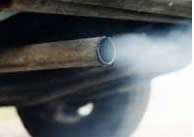
Candles burn carbon
A project with a candle and a spoon
You can see the relationship between carbon, oxygen, and hydrogen easily at home or at school. You’ll need a candle. Most candles are either made from paraffin wax or from beeswax. It doesn’t matter which you have for this experiment.
What is beeswax?
What is carbon?
All our chemistry projects
Light the candle and let it burn for a minute. Then hold a cold metal spoon over the flame. Black gunk will get on the spoon. That’s carbon. You should also see little drops of water.
Why did carbon get on the spoon?
Here’s why:
Wax is made from hydrocarbon molecules – long chains of hydrogen and carbon atoms. When the wax gets hot, the heat breaks up these molecules into much smaller molecules which mix with oxygen in the air. This mixing makes different molecules, all made of carbon, hydrogen, and oxygen.
What are hydrocarbons?
What is carbon dioxide?
The carbon mixes with oxygen to make carbon dioxide (one carbon atom and two oxygen atoms) and carbon monoxide (one carbon and one oxygen). The hydrogen mixes with oxygen to make water (one hydrogen atom and two oxygen atoms) – you saw the water on your spoon. Some of the carbon doesn’t mix with anything, and that shows up on the spoon as the black gunk.
A project with cars and coffee filters

Car tailpipe shooting out carbon
You can see this same process at work in your car. The gas tank of a car has hydrocarbons in it – molecules made of long chains of hydrogen and oxygen, just like candle wax.
What is electricity?
What is gasoline?
Combustion reactions
When you add oxygen and a spark of electricity to get it going, your car burns the hydrocarbons inside the engine, just like the candle burns. And, just like the candle, your car produces carbon dioxide, carbon monoxide, plain old carbon, and water. To see the carbon, hold a cloth rag or a paper towel or a coffee filter over the exhaust pipe while someone runs the car for a few minutes. You may even be able to collect some water on your paper towel from the exhaust pipe, just as the water collected on the spoon.
Is there also carbon in food?
Because all living things – plants and animals – are also made of carbon, you can also see carbon when you burn your food. Try frying up some potatoes in oil in a frying pan. If you don’t keep stirring, parts of the potato will turn black. That’s carbon from the potato. If you burned yourself (don’t do this!) badly enough, you’d turn black too, from the carbon in you.
Where do potatoes come from?
More about carbon
More chemistry projects
Bibliography and further reading about science projects:




